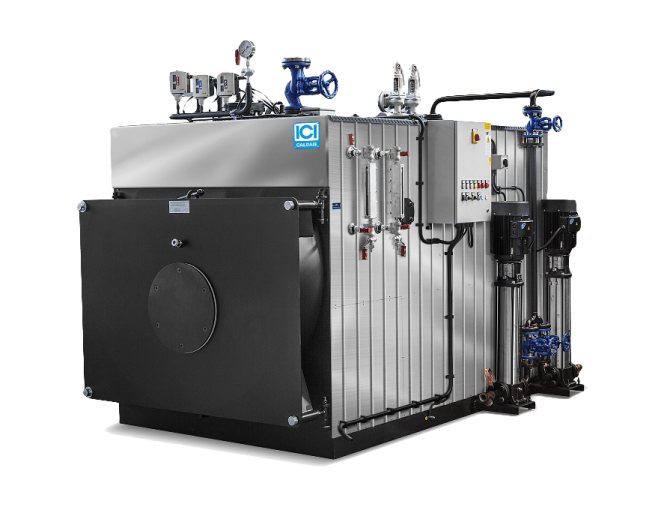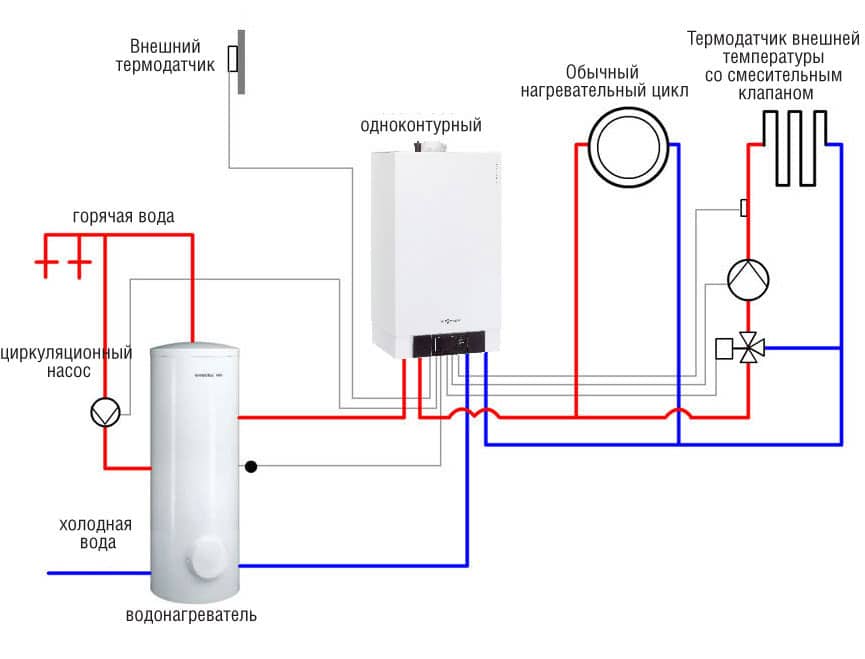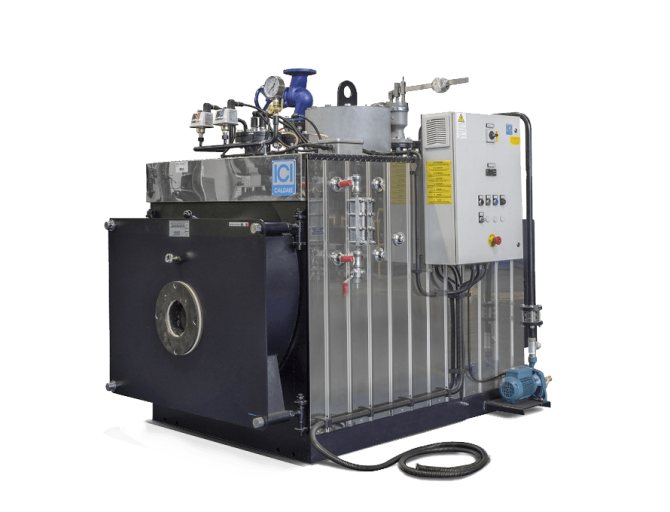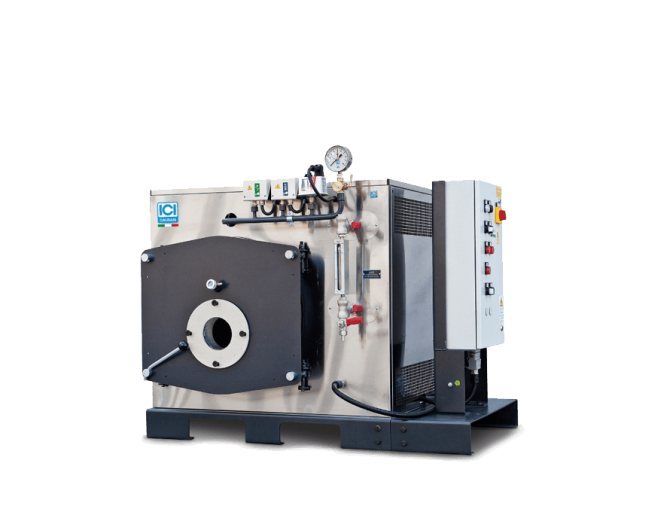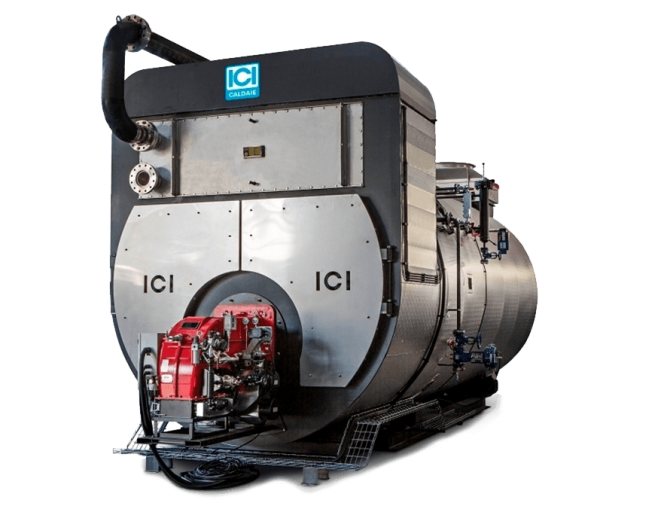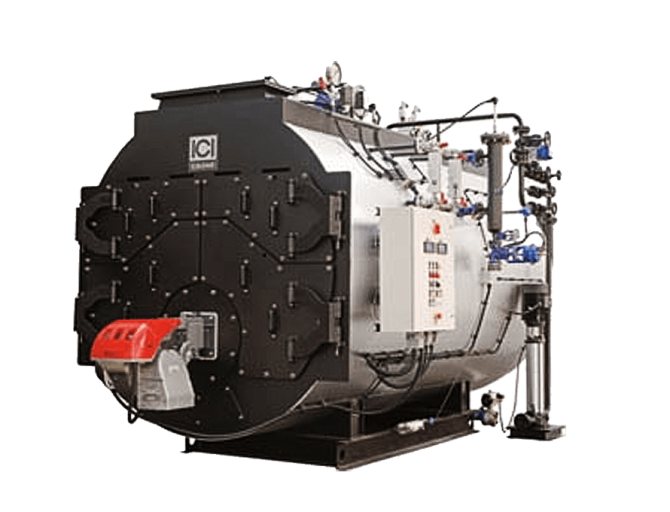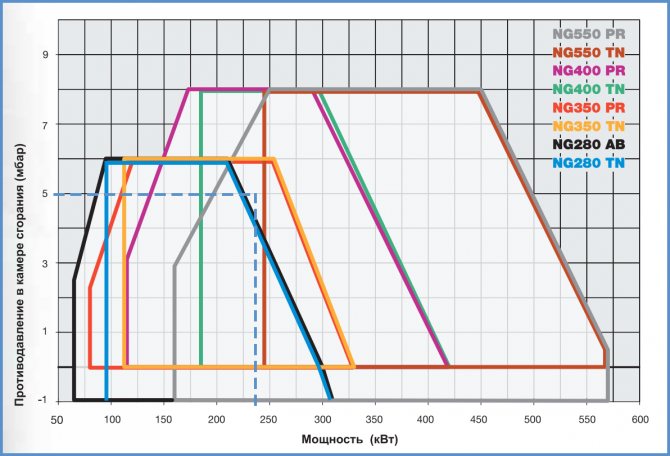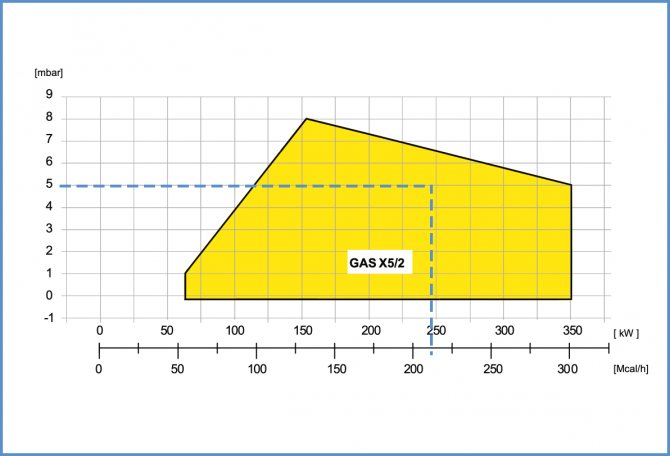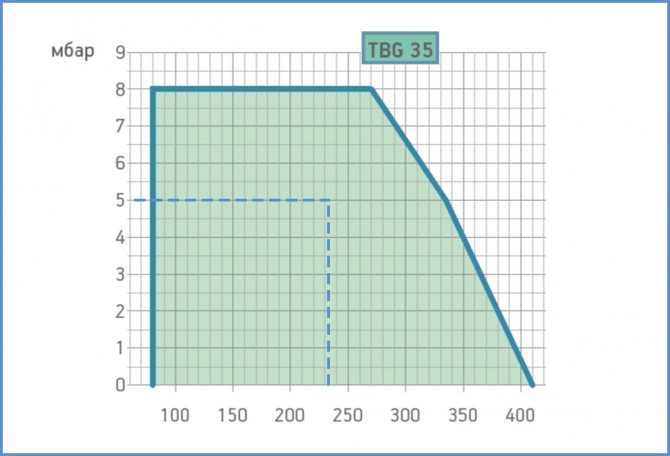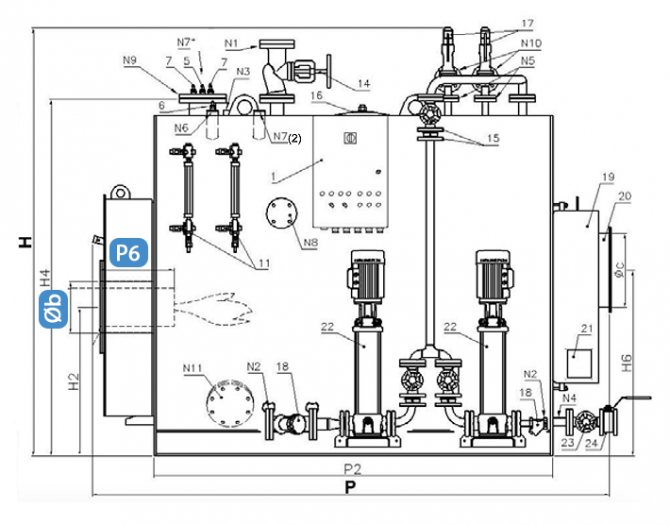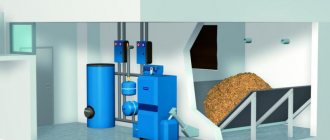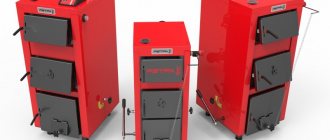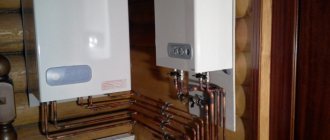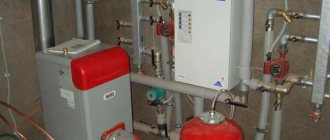
The gas burner for the boiler is its most important component. The choice of this component determines the operation of the boiler, its efficiency and productivity.
The demand for such burners is quite high, since the type of fuel used in them is considered one of the cheapest today. There is a wide range of gas burners. Therefore, in this matter, you need to be careful and take into account all aspects.
What is a gas burner?
Gas burners for boilers are structures inside which gas and oxygen are mixed. The mixture flows to the outlets and there it is ignited by a spark or piezoelectric element and a stable, stable torch is formed.
The main task of the listed elements in boilers is to maintain a stable and constant combustion of the resulting mixture. As you can see, the design of a boiler with a gas burner is quite simple and its installation will not cause difficulties.
A gas burner consists of several units: a nozzle, an ignition system, an automation system and a flame detector.
Its structure should be, first of all, safe. In addition, this element of the heating boiler must burn the mixture without residue, and the emission of harmful substances must be minimal.
Low noise level is another of the requirements for devices. Be sure to pay attention to the service life.
Gas burners of automatic heating boilers are another safety requirement. As soon as the fire is extinguished, the fuel supply is automatically stopped. This is one of the main criteria for her choice.
They have found their application in household heating stakes and in industry. Gas, despite its high consumer qualities, has a rather low cost in comparison with other types of fuel. This makes gas burners demanded and popular.
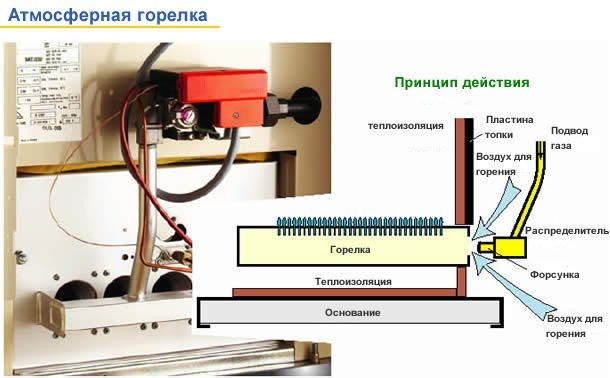

Atmospheric gas burner.
Today, gas AOGV boilers are of great interest - heating gas water heaters. A distinctive feature here is the volatility of boilers, that is, they can work without an electrical network.
In addition, the noted devices are fully automated by the ACS control system, which plays the role of an automatic thermostat and reduces the amount of fuel consumed.
The main elements of the automatic control system
Devices included in the burner electrical circuit for automatic operation:
- The switch for maximum and minimum gas pressure has a simple design, which affects its long service life. Its principle of operation is that the gas pressure acts on the diaphragm, and if it deviates from the set value, it is triggered and the control valve makes the necessary adjustments. The minimum gas pressure switch protects against a drop in gas pressure to a critical value, and the maximum pressure switch adjusts, preventing the permissible value from being exceeded.
- The thermostat is a signaling device for reaching the temperature limit values. On its signal, the combustion modes change.
- The combustion controller is an element that integrates the operation of the entire burner into a single process. The burner operation is divided into several points, which correspond to a certain position of the air damper and the fuel regulating valve. When a low temperature signal is received, appropriate mechanisms are opened to increase the combustion power.The controller's operation is based on signals from various sensors (pressure, temperature).
- Relays for minimum and maximum coolant pressure protect the heating system from excessive drop and increase in coolant pressure. Both cases are dangerous for the continued operation of the boiler, therefore, when a critical value (lower or upper) is reached, the boiler turns off, that is, the gas supply stops.
- The boiler filling sensor is needed to provide protection against turning on the burner without the presence of a coolant in the boiler.
The connection of the sensors depends on the brand of the boiler, this information can be found in the passport of the unit, and the features of connecting the sensors are described in detail in the attached instructions.
The connection and configuration of the automation system must be supervised by a gas service specialist. Commissioning is also carried out in his presence with the obligatory drawing up of an act on the suitability of the equipment for safe operation.
Classification of gas burners
The main types of gas burners: atmospheric / injection, blowing / ventilation, and diffusion-kinetic. The first is characterized by an open combustion chamber. Air is supplied by being sucked in by a gas stream.
Atmospheric gas burners are a tube or several tubes where fuel is supplied. A low pressure is formed in the tube, due to which air is sucked in from the room. These burners are usually part of the boiler.
Most often, atmospheric gas burners are used for domestic heating boilers. The area that they can heat is no more than 100 sq.m. In addition, heaters can be used in boilers of various types - from expensive to cheap designs.
Blowing gas burners for a heating boiler have a more complex design and principle of operation.
Ventilation burners have a closed combustion chamber. Here, air is supplied by a fan. Thus, it becomes possible to set the flow rate of the gas-air mixture. This in turn leads to high efficiency values.
Blast burners must be purchased separately from the boiler, as an additional unit.
These burners for heating boilers have their own advantages. Firstly, it is safety, since they have a closed combustion chamber. The second advantage is the high level of efficiency. Blower gas burners for boilers are insensitive to pressure changes.
They also have their disadvantages: a high noise level compared to atmospheric, high energy costs, and the high cost of the device itself.
As for diffusion-kinetic gas burners, they occupy an intermediate place between atmospheric and blast burners. Air is not supplied to the chamber completely, then it is added to the flame. They are not used in domestic boilers.
This type of burner has its pros and cons. The main advantage is considered to be the achievement of the maximum value of efficiency. The downside here is the high cost.
Gas boiler fan burners
Fan or forced draft burners, work due to the intake of air from the street, with the help of a fan. The fan is adjustable. Burners with external air supply work stably at any gas pressure, for such boilers there is no need to make vertical chimneys, a coaxial chimney is enough, the efficiency of such boilers is close to 95%. True, they work noisily and cost 2 times more than atmospheric burners.
It should be noted that fan burners are mounted on the boiler. This makes it possible to change the burner and switch from gas to liquid fuel.
Other differences
In addition to the above, depending on the type of regulation, other types of gas burners are distinguished. These include single-stage, two-stage, sliding-two-stage, modulated.


The structure of the gas burner.
The principle of operation of single-stage gas burners is to automatically close the gas valve as soon as the heating medium heats up to a certain temperature. Thus, the gas burner is automatically extinguished.
After the gas reaches the lower limit temperature, the gas valve is automatically opened, which leads to full ignition of the burner. Such devices are very convenient to use in gas household appliances.
Two-stage gas burners for the boiler operate in two systems - 40% and 100%. The burner starts working at 40% as soon as the coolant heats up to the required temperature and the gas valve is closed. The automatic system allows you to switch from one system of work to another.
The continuously variable two-stage gas burners operate in two modes. Here, the transition to another mode is carried out more smoothly than in two-stage.
For continuous heating of the boiler, modulating burners are used. Unlike a boiler with an atmospheric burner, this type of burner covers a wide power range. In addition, modulating options significantly save gas.
Due to the automation of the process, the service life of such units is much longer. The flame height in a gas burner for modulating heating is automatically adjusted.
In turn, modulated variants are classified depending on the principle of operation of modulating units.
Burners with modulation are distinguished:
- mechanical;
- pneumatic;
- electronic.
Electronic modulating burners provide high control accuracy. Modulating gas burners made in Italy are considered the best today.
Condensing boiler working principle
The condensing boiler is the little brother of the most common gas-fired convection boiler. The principle of the latter is extremely simple, and therefore understandable even to people who are poorly versed in physics and technology. The fuel for a gas boiler, as its name implies, is natural (main) or liquefied (balloon) gas. When blue fuel is burned, like any other organic matter, carbon dioxide and water are formed and a large amount of energy is released. The released heat is used to heat the coolant - process water circulating through the heating system of the house.
The efficiency of a gas convection boiler is ~ 90%. This is not so bad, at least higher than that of liquid and solid fuel heat generators. However, people have always tried to bring this indicator as close as possible to the cherished 100%. In this regard, the question arises: where does the remaining 10% go? The answer, alas, is prosaic: they fly into the chimney. Indeed, the products of gas combustion leaving the system through the chimney are heated to a very high temperature (150-250 ° C), which means that 10% of the energy we lost is spent on heating the air outside the house.
Scientists and engineers have been looking for a more complete heat recovery for a long time, but a method for the technological implementation of their theoretical developments was found only 10 years ago, when a condensing boiler was created.
What is its fundamental difference from the traditional convection gas-fuel heat generator? Having worked out the main process of fuel combustion and transferring a significant part of the heat released at the same time to the heat exchanger, the condenser cools the gaseous combustion products to 50-60 ° C, i.e. to the point where water condensation begins. This is already enough to significantly increase the efficiency, in this case, the amount of heat transferred to the coolant. However, this is not all.
Traditional gas boiler
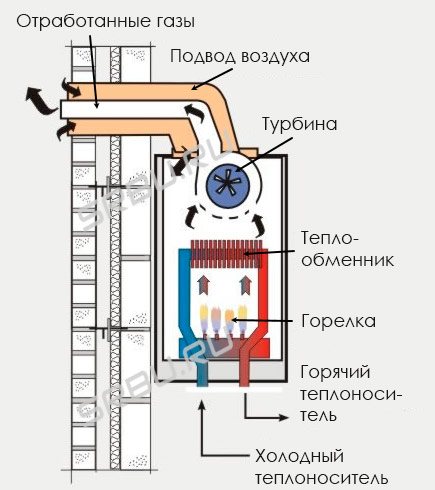

Condensing gas boiler
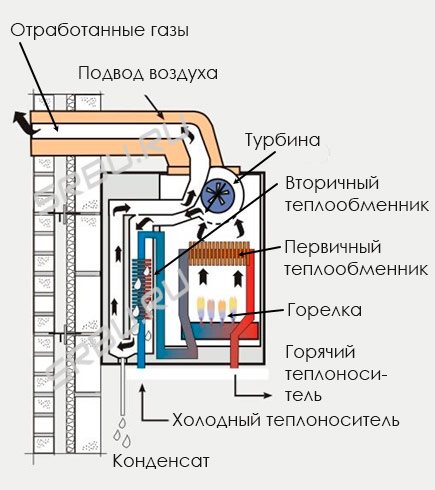

At a temperature of 56 ° C - at the so-called dew point - water changes from a vapor to a liquid state, in other words, condensation of water vapor occurs.In this case, additional energy is released, at one time spent on the evaporation of water and in conventional gas boilers is lost along with the volatilizing vapor-gas mixture. The condensing boiler is able to “take” the heat released during the condensation of water vapor and transfer it to the coolant.
Manufacturers of condensing-type heat generators invariably draw the attention of their potential customers to the unusually high efficiency of their devices - above 100%. How is this possible? In fact, there is no contradiction to the canons of classical physics here. It's just that in this case they use a different settlement system.
Often, when evaluating the efficiency of heating boilers, it is calculated how much of the released heat is transferred to the coolant. Heat, "taken away" in a conventional boiler, and heat from deep cooling of flue gases will give a total of 100% efficiency. But if we add here the heat released during steam condensation, we get ~ 108-110%.
From the point of view of physics, such calculations are not entirely correct. When calculating the efficiency, it is necessary to take into account not the released heat, but the total energy released during the combustion of a mixture of hydrocarbons of a given composition. This will also include the energy spent on converting water to a gaseous state (subsequently released in the process of condensation).
It follows from this that the efficiency exceeding 100% is just a cunning move by marketers exploiting the imperfection of the outdated calculation formula. Nevertheless, it should be recognized that the condensate, unlike a conventional convection boiler, manages to "squeeze" all or almost all of the fuel combustion process. The positives are obvious - higher efficiency and reduced consumption of fossil resources.
Types of universal boilers using a gas burner
Let's take a look at the example of a universal firewood-coal-gas boiler. In such boilers, an atmospheric gas burner is used, where gas and air are mixed naturally. You can also use a blower system equipped with a fan.
Which one to choose is up to the buyer, but it should be mentioned: fan models are volatile and more noisy.
The automated gas burner is carried out using a fan circuit. Gas and air are mixed in it, after which the resulting mixture enters the nozzle and ignites.


Design features of a burner for a gas boiler.
A fan, a reducer and an automation system are built into the side of the burner, with the help of which the gas burner is regulated.
Today, the most famous are the universal gas / diesel boilers, since the structure of these substances during combustion is very similar. Thus, the changeover to another fuel is quick and easy.
There are also more expensive models of universal boilers that run on many types of fuel. For example, boilers firewood-coal-electricity-gas-liquid fuel. Here, one type of fuel is the main one. It is on the basis of it that the boiler power is calculated. Accordingly, other types of fuel are secondary.
The use of a liquid fuel cell will reduce the efficiency of heating equipment. During the heating of wood, diesel, briquettes, the heat rises from the bottom up and heats the coolant. If a torch is used, it spreads horizontally.
As a result, the back wall of the boiler is most exposed to heat. After a long period of use, it may burn out.
Additional insulation will help solve this problem. Diesel fuel should be stored in appropriate places. These include plastic containers, rooms with a protective pallet. Sometimes it is buried next to the boiler room, if the soil allows. The storage issue should be thought out in advance.
Universal boilers are often used in car repair shops.If the object is located in a place without access to the gas main, then universal heating devices will be an excellent choice.
As fuel, you can use not only wood, coal or pellets, but also waste oil. This fuel provides a fairly high efficiency.
At the same time, the flow rate can vary significantly depending on the power. A sufficient supply of this material is required, which is possible only with a large turnover.
The transition from heating one type of fuel to another is sometimes simple, and sometimes laborious. Changing the diesel to gas can pose a particular danger. The first, as a result of long-term operation of the heating system, leaves soot in the chimney.
After switching to gas, it can crumble and block the chimney. Then carbon monoxide can enter the room, which is fraught with serious consequences.
Of course, the burner should shut down automatically in this case. Nevertheless, it is not worth risking your life and it is better to turn to specialists. They will definitely, after changing the heating operation mode, clean the chimney.
All of the above transition conditions are characteristic only of one-type systems. Their design provides for the combustion of fuel in one chamber. On the one hand, such a device is the most economical. If a frequent change of regimes is not planned, then it makes no sense to overpay.
According to the materials used, boilers are divided into cast iron and metal. The first option is the most reliable. They are designed to withstand severe thermal loads. They are able to provide a long service life even at high operating powers.
The disadvantages of these devices are their bulkiness and weight. During the selection, it is necessary to consider in advance all possible options for operating the specified heater.
Double-fired boilers are more practical and easier to use. Especially when it comes to frequent switching from one type of fuel to another. At the same time, they have significant dimensions. The furnaces in them can be located in different ways: next to each other, one above the other.
In this case, the same coolant circuit is heated by different types of fuel, and the transition is carried out without additional installation work, manually or automatically, depending on the additional equipment used.
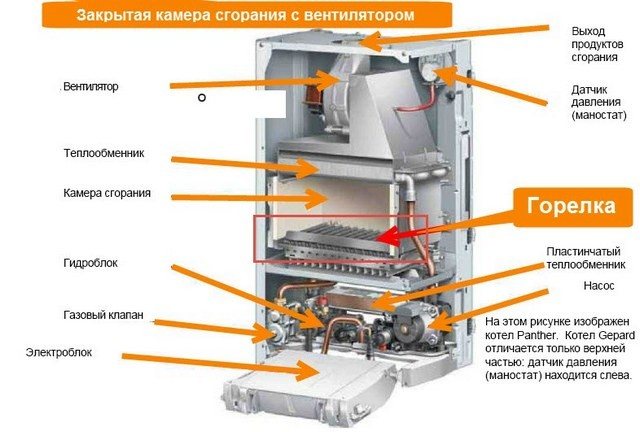

The device of a gas boiler with a burner.
Each compartment is made specifically for a specific type of fuel. The result is high efficiency and cost-effectiveness by changing the operating mode. The transition from one work option to another does not cause any difficulties. In some models, it can be done automatically.
These heating systems are especially effective in conditions of power outages, unstable gas supply, and high cost of connecting to the mains.
Given the availability of solid fuel materials and their relatively low cost, they have no equal. On the other hand, the price of a universal system is quite high.
Wall mounted boilers
Wall-hung boilers cannot have high power, the limit is 65 kW. The service life of wall-mounted boilers, the overwhelming majority of which are equipped with copper heat exchangers, is less than that of floor-standing ones. True, in the "advanced" models, very durable aluminum heat exchangers are used, but they are also much more expensive. Nevertheless, today wall-mounted systems have largely replaced floor-standing systems. The reason is lower cost, compactness and versatility. Almost all models are self-sufficient: they are equipped with a built-in circulation pump, a safety group, automatic control, many have an expansion tank and a heat accumulator. Thanks to this, the installation of a gas boiler is possible in a small room or in the kitchen, which is especially convenient for an apartment heating system, in a town house, a small cottage.
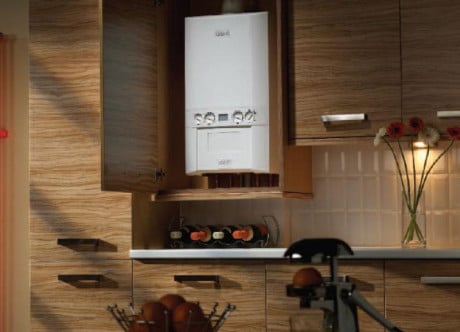

One of the advantages of wall-mounted boilers is compactness.
Types of wall-mounted boilers:
- Wall-mounted boilers with atmospheric burners are widespread due to their low cost, structurally simple. Along with full-featured ones, you can also find models without automation and a pump, which do not need power supply.
- Turbocharged wall-mounted boilers are the next step in the development of heating technology. With the help of a fan located in the upper part of the boiler, the gas-air mixture enters the furnace, and the combustion products are removed forcibly. This design makes it possible to use a small diameter coaxial pipe instead of a traditional chimney. Moreover, there is no need to build an exit to the roof; it is enough to bring the chimney out into the street directly through the outer wall at a height of at least two meters from the ground level. Burners for turbocharged boilers are two-stage or modulated.

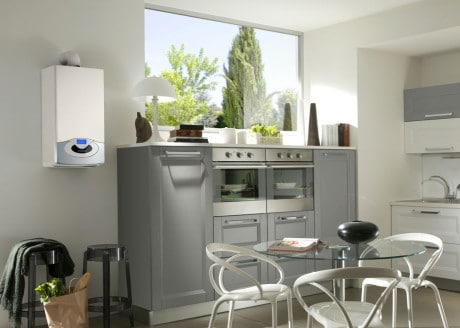
A turbocharged boiler does not need a traditional chimney. Air intake and outflow of combustion products can be carried out with a horizontal coaxial pipe through the outer wall - Wall mounted condensing boilers are the most advanced gas boiler for the home today. They use pressurized, modulating burners, heat exchangers are made of high-alloy steel, more expensive and durable ones are made of aluminum alloy. The heat exchanger is equipped with an economizer that recovers the heat energy of the exhaust gases, which in a conventional boiler "escapes into the pipe". The use of this technology can reduce fuel consumption by a quarter. The advantages of condensing boilers are fully realized when operating in a low-temperature heating system, where the temperature of the coolant in the supply line is reduced to 55 ° C against the traditional 80 ° C. Fully heated floors correspond to such a system; radiators must have an increased volume. During operation, a fairly large amount of condensate is formed (up to 0.5 liters per 1 kW of power per day), which can be discharged into the sewer. There are also floor standing condensing boilers, but they are not widely used.
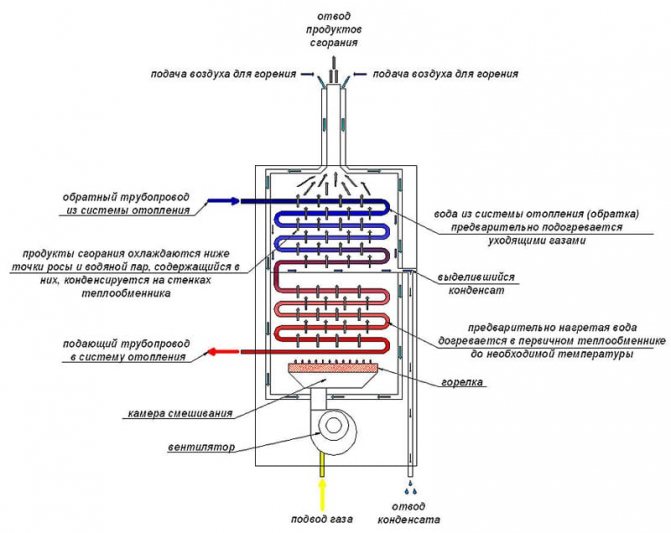

Schematic diagram of a condensing boiler. When designing and installing the sewage system, a condensate drain should be provided.
Homemade units
There are craftsmen who remodel heating systems with their own hands. On the Internet, you can even find the necessary schemes for changing the devices of gas burners, their installation and adjustment.
Usually, metal is used as a material for the manufacture of heating systems. A cast iron firebox would be much more reliable. However, it is not possible to use it at home.
An excellent option for manual work is ordering the system from specialists. They will be able to manufacture the device in accordance with all the wishes of the customer. However, the likelihood of defects in the boilers is not excluded, which may appear after some time.
What are homemade heating units for? The fact is that the marked options have a lower cost. They are made mainly because of the desire to save money. At the same time, these options are inferior to their factory counterparts in efficiency.
Over a long period of use, it may turn out that a homemade version will be even more expensive.
Usually only solid fuel and electrical units are made. Tinkering with gas and diesel boilers is extremely dangerous. In addition, their installation in the house is strictly prohibited.
According to the principle of operation, a home-made product is no different from a purchased option. It will burn fuel and heat the coolant filled with water.
The main disadvantage of this unit is the lack of a guarantee. The plant equipment will work and perform its functions. Even if the buyer stumbles upon a defect, he will be able to change the product for another.
It is better to use pellets, firewood, coal as fuel in hand-made units. These materials are less hazardous than gas.Heating devices cannot be made on the basis of the latter.
Simple solid fuel units are the most popular and common home-made devices. They are simple and their design is very similar to a conventional oven. In addition, they are versatile.
Like a conventional furnace, these systems are capable of operating on any solid fuel. The main thing is to burn.
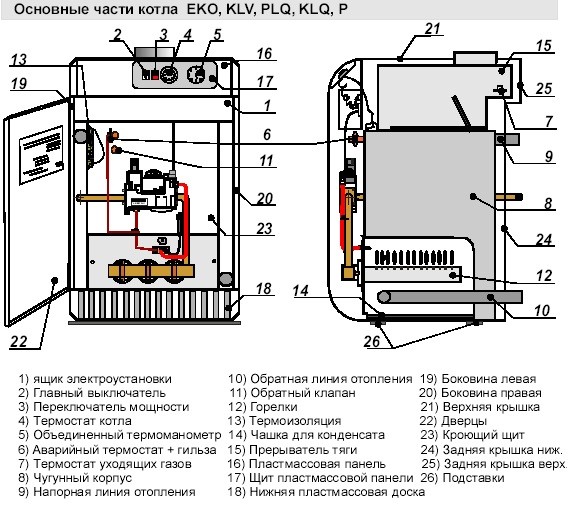

The main parts of the gas boiler.
The efficiency of homemade equipment is significantly lower than the factory one. It is influenced by many factors.
Among them:
- thermal insulation;
- completeness of combustion;
- the correctness of the conclusions.
The efficiency of the unit directly depends on the combustion temperature. The higher it is, the lower the efficiency. In high-quality systems, the temperature in the furnace is maintained at 120–150 ° C. Higher values reduce the safety of pipes. This, in turn, significantly reduces the durability of the unit.
When manufacturing boilers with a burner, it is better to protect yourself as much as possible from the possible consequences of its operation. Therefore, a separate purchase of an automatic gas burner should be considered, which will be installed in an atmospheric or blower boiler room.
You can also make electric heating units with your own hands. Their design can be different. It all depends on the requests of the person. The simplest option is to install a heating element directly into the heating system. In this case, there is no need to manufacture the boiler.
The pipe with the heater must have a sufficiently large diameter. It should be easily removable for repair and cleaning.
Systems without a heater deserve special attention. Its role is played by the water itself. A current is passed through it, and due to the movement of water ions, heating occurs. The liquid itself must contain salt.
It is extremely difficult to make such a device. The electric current passes directly through the coolant, so the entire system must be reliably isolated.
One of the dangers of this device is electrical breakdown. Essentially the same as a short circuit. Gas can also accumulate in the system. As a result, the heating efficiency will decrease.
Of the above, the solid fuel unit is the best option. Its body can be assembled from heat-resistant steel. It is characterized by increased strength, less wear and tear and high resistance to thermal effects.
Nevertheless, heat-resistant steel is expensive and is rarely used in homemade boilers in practice. Another option is cast iron: this material tolerates heat well, although it is difficult to work with it. Equipment for the manufacture of a cast iron stove is available only at specialized enterprises.
It is important to understand that without proper experience and skills, it is better not to tinker with the heating system with your own hands. Safety must come first. It is enough to admit even one inaccuracy, and this can lead to disastrous consequences.
Outcome
Gas burners have found their application in domestic heating pipes as well as in industry. Gas, despite its high consumer qualities, has a rather low cost in comparison with other types of fuel. This makes gas burners demanded and popular.
This review discusses the main types of gas burners, their advantages and disadvantages. This information will definitely come in handy when choosing a boiler for heating, taking into account the place of its use: house, apartment, summer cottage.


